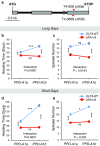Genetic and physical mapping of the earliness per se locus Eps-A (m) 1 in Triticum monococcum identifies EARLY FLOWERING 3 (ELF3) as a candidate gene
- PMID: 27085709
- PMCID: PMC4947483
- DOI: 10.1007/s10142-016-0490-3
Genetic and physical mapping of the earliness per se locus Eps-A (m) 1 in Triticum monococcum identifies EARLY FLOWERING 3 (ELF3) as a candidate gene
Abstract
Wheat cultivars exposed to optimal photoperiod and vernalization treatments still exhibit differences in flowering time, referred to as earliness per se (Eps). We previously identified the Eps-A (m) 1 locus from Triticum monococcum and showed that the allele from cultivated accession DV92 significantly delays heading time and increases the number of spikelets per spike relative to the allele from wild accession G3116. Here, we expanded a high-density genetic and physical map of the Eps-A (m) 1 region and identified the wheat ortholog of circadian clock regulator EARLY FLOWERING 3 (ELF3) as a candidate gene. No differences in ELF3 transcript levels were found between near-isogenic lines carrying the DV92 and G3116 Eps-A (m) 1 alleles, but the encoded ELF3 proteins differed in four amino acids. These differences were associated with altered transcription profiles of PIF-like, PPD1, and FT1, which are known downstream targets of ELF3. Tetraploid wheat lines with combined truncation mutations in the A- and B-genome copies of ELF3 flowered earlier and had less spikelets per spike than the wild-type control under short- and long-day conditions. Both effects were stronger in a photoperiod-sensitive than in a reduced photoperiod-sensitive background, indicating a significant epistatic interaction between PPD1 and ELF3 (P < 0.0001). By contrast, the introgression of the T. monococcum chromosome segment carrying the Eps-A (m) 1 allele from DV92 into durum wheat delayed flowering and increased the number of spikelets per spike. Taken together, the above results support the hypothesis that ELF3 is Eps-A (m) 1. The ELF3 alleles identified here provide additional tools to modulate reproductive development in wheat.
Keywords: ELF3; Earliness per se; Flowering time; Spikelet number; Triticum monococcum; Wheat.
Figures





References
-
- Appendino ML, Slafer GA. Earliness per se and its dependence upon temperature in diploid wheat lines differing in the major gene Eps-Am1 alleles. J Agr Sci. 2003;141:149–154. doi: 10.1017/S0021859603003472. - DOI
-
- Beales J, Turner A, Griffiths S, Snape JW, Laurie DA (2007) A Pseudo-Response Regulator is misexpressed in the photoperiod insensitive Ppd-D1a mutant of wheat (Triticum aestivum L.). Theor Appl Genet 115:721–733 - PubMed
-
- Box MS, Huang BE, Domijan M, Jaeger KE, Khattak AK, Yoo SJ, Sedivy EL, Jones DM, Hearn TJ, Webb AA, Grant A (2015) ELF3 controls thermoresponsive growth in Arabidopsis. Curr Biol 25:194–199 - PubMed
MeSH terms
Substances
LinkOut - more resources
Full Text Sources
Other Literature Sources

